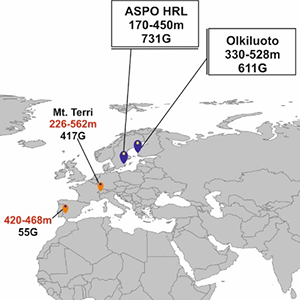Contact
Department of Aquatic Sciences and Assessment, Division of Microbial Ecology
Department of Aquatic Sciences and Assessment, Division of Microbial Ecology

Habitats deep under the earth’s surface can host high biodiversity. New genetic methods have enabled studies that show that eukaryotes, bacteria, archaea and viruses are present in the so-called deep biosphere, habitats deep under the earth’s surface and the ocean floor. The aim of this project is to create a database of the microbial diversity in the deep biosphere and to explore the processes that create this diversity.
The Fennoscandian Shield is the focus of the project. Here, the bedrock contains an abundance of fracture zones with different groundwater characteristics that vary in water source, retention time, chemistry, and connectivity to surface-fed organic compounds.
This project is centered at the Äspö Hard Rock Laboratory (HRL) where we have sampled deep biosphere microbial communities over time and in waters of differing ages and both planktonic and biofilm-associated communities. This long-term effort has generated firsthand understanding of this unique ecosystem and has culminated in a genome-resolved understanding of the Fennoscandian Shield bedrock Archaeal and bacterial communities enabled by an integrated multi-omics analysis combining metagenomes, single-cell genomes and metatranscriptomes. By combining this with 17 metagenomes and 283 single-cell amplified genomes originating from different drillholes in Olkiluoto (Finland), we have performed a synoptic study of the deep biosphere microbiome of the deep biosphere.
Our comparative genome-resolved analysis of the prokaryotic community in disconnected fracture fluids of the Fennoscandian Shield shows that the oligotrophic deep groundwaters flowing in similar lithologies offer fixed niches that are occupied by a common deep groundwater core microbiome and provide clues to their eco-evolutionary adaptations for thriving in these oligotrophic ecosystems.
The project is carried out in close collaboration with Prof. Mark Dopson and his research group at The Linnaeus University and Rizlan Bernier Latmani at the EPFL (Switzerland).
Funded by VR, JGI and SciLifeLab (2018-2021).